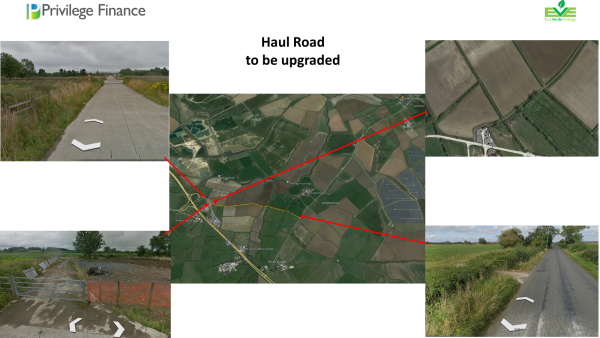Traffic Management
Introduction
This submission provides an update to the traffic management strategy initially set out in the original highways report prepared by RSK in February 2023. It addresses the concerns raised by National Highways regarding the use of the A419/C114 junction by delivery vehicles. In particular, this update presents a revised proposal to ensure that no delivery vehicles use the A419/C114 junction and that all site traffic enters and exits via a grade-separated junction, in line with National Highways’ recommendations.
The revised traffic strategy focuses solely on the traffic associated with new feedstock deliveries to the expanded Castle Eaton Anaerobic Digestion (AD) plant, while also proposing improvements for managing existing consented traffic. This ensures a safe and sustainable traffic management plan that addresses the concerns raised by National Highways.
2. Background and Scope
National Highways previously raised concerns about the potential traffic impact at the A419/C114 junction, specifically regarding the use of this junction by delivery vehicles associated with the Castle Eaton AD plant. To address these concerns, we have reviewed the traffic management strategy and made necessary adjustments to ensure that the A419/C114 junction is not used by delivery vehicles.
The key adjustment to our proposal is the exclusive use of an upgraded haul road between Calcutt and the C114 (specifications attached in Appendix II), which will now accommodate both large tractors and trailers as well as HGVs. This haul road provides a direct route to the plant, via a grade-separated junction, and eliminates the need for delivery vehicles to use the A419/C114 junction.
Additionally, all currently consented delivery traffic, which has historically used the A419/C114 junction, will now also be redirected via the upgraded haul road. This change will result in a reduction in traffic at the A419/C114 junction, alleviating National Highways' concerns about increased traffic at this location.
The focus of this submission is on the new traffic movements generated by the additional feedstock deliveries associated with the planned increase in plant capacity, as well as the redirection of existing traffic.
3. Updated Traffic Management Plan
The Castle Eaton AD plant is set to increase its annual feedstock processing capacity by 8050 tonnes, requiring adjustments to the delivery logistics to manage the additional traffic efficiently and sustainably. Approximately 50% of the total feedstock (8,145 tonnes) will be delivered during the harvest season, which spans approximately 150 days from late spring to mid-autumn. The remaining 50% of feedstock will be delivered steadily throughout the rest of the year.
Under the revised plan, all new delivery vehicles (both tractor/trailer units and HGVs) will follow a single, designated route to access the site:
- Access Route: All delivery vehicles will enter the site via the grade-separated junction at Calcutt, using the upgraded haul road to reach the plant. This road will be upgraded to a suitable standard (see Appendix II for specifications) to support safe and efficient access for large tractor and trailer units as well as HGVs.
- Redirection of Existing Traffic: In addition to the new feedstock deliveries, all current delivery traffic that would previously have used the A419/C114 junction will also be redirected via the upgraded haul road. This will significantly reduce the volume of vehicles using the A419/C114 junction.
This revised routing plan achieves two primary goals:
- Compliance with National Highways’ Requirements: The exclusive use of a grade-separated junction aligns with National Highways’ recommendation to improve traffic safety and reduce congestion at the A419/C114 junction.
- Efficient Traffic Flow: The use of the upgraded haul road ensures a direct and efficient route for all delivery traffic, minimizing disruption to the local road network while reducing the pressure on the A419/C114 junction.
4. Traffic Movements Associated with New Feedstock
The proposed increase in feedstock delivery will generate additional traffic movements, but the impact of these movements will be carefully managed through the revised routing plan. Below is a detailed breakdown of the expected traffic associated with the 16,290 tonnes of new feedstock deliveries:
- Feedstock Transport Mode: The new feedstock will be delivered using a combination of large tractor and trailer units and HGVs, depending on the source location and delivery requirements.
- Seasonal Deliveries: Approximately 50% of the new feedstock (8,145 tonnes) will be delivered during the harvest season, which lasts approximately 150 days from late spring until mid-autumn. This will result in a peak in daily vehicle movements during this period. The remaining 50% of feedstock will be delivered consistently throughout the rest of the year, helping to balance traffic flows.
- Vehicle Load Capacity: Tractor/trailer units are expected to carry approximately 16 tonnes per trip, while HGVs will carry around 27 tonnes per trip.
- Vehicle Movements:
- During the harvest season, delivery traffic will increase, with approximately 5-6 tractor and trailer deliveries per day (each way) spread over 150 days, depending on load capacity and the total tonnage.
- During the non-harvest period, delivery traffic will decrease to around 1-2 tractor/trailer deliveries per day (each way) over the remaining 150 days.
- HGV deliveries will be distributed throughout the year, with an estimated 1-2 HGV deliveries per day based on the availability and scheduling of feedstock.
This traffic is expected to be consistent and manageable, with the haul road efficiently supporting the delivery vehicles and ensuring no traffic impacts on the A419/C114 junction.
